This site uses cookies as defined in our Cookie Policy, by continuing to use this site you agree to their use.
Continue
Get the pulse racing on a thrilling Southern African adventure, before heading off in leisurely pursuit of idyllic Indian Ocean islands. Bustle through Mozambique’s capital before a spell at sea provides guilt-free indulgence aboard the Silver Spirit. Endemic baobab trees salute, as you explore Madagascar’s brilliant bundle of curious creatures and mind-boggling biodiversity. A sweet Seychelles cocktail of magnificent palm jungles, sparkling ocean and blissful beaches serves as a fitting digestif.
| Arrive | Depart | ||||||
| 9th09 | MarMar | 202525 | Cape Town, South Africa, embark on the Silver Spirit | ||||
Sometimes referred to as the Mother City, Cape Town is the most famous port in South Africa and is influenced by many different cultures, including Dutch, British and Malay. The port was founded in 1652 by Dutch explorer Jan Van Riebeeck, and evidence of Dutch colonial rule remains throughout the region. The port is located on one of the world's most important trade routes, and is mainly a container port and handler of fresh fruit. Fishing is another vital industry, with large Asian fishing fleets using Cape Town as a logistical repair base for much of the year. The region is famous for its natural beauty, with the imposing Table Mountain and Lions Head, as well as the many nature reserves and botanical gardens such as Kirstenbosch which boasts an extensive range of indigenous plant life, including proteas and ferns. Cape Town's weather is mercurial, and can change from beautiful sunshine to dramatic thunderstorms within a short period. A local adage is that in Cape Town you can experience four seasons in one day. Sprawling across endless, staggeringly blue coastline, and watched over by the iconic plane of Table Mountain, Cape Town is without doubt one of the world’s most beautiful cities. A blend of spectacular mountain scenery, multiculturalism and relaxed ocean charm awaits in the Mother City, where you can venture out to rolling vineyards, dine in laid back sea suburbs, or spend days exploring cool urban culture. Cape Town’s natural splendour fully reveals itself as the cable car rears sharply to the top of Table Mountain. From the summit, 3,500 feet above sea level, you can let the scale of the panoramic vistas of the city rolling down towards the ocean wash over you. Another heavenly perspective waits at the top of Lion's Head’s tapering peak. A sharp hike and an early start is required, but the views of the morning sun painting Table Mountain honey-gold are some of Cape Town’s finest. Cape Town’s glorious sunshine and inviting blue rollers can be a little deceiving - these oceans are anything but warm at times, with nothing between the peninsula’s end and Antarctica’s icy chill. This cool water has upsides though, bringing a colony of adorably cute African penguins to Boulders Beach. Boarded walkways offer the perfect vantage point to see the cute creatures dipping into the sea and lounging in the sun. Nearby, journey to the end of Africa at the Cape of Good Hope, where you can stand at the bottom of this mighty continent, watching out over the merging waves of the Atlantic and Indian Oceans. Cape Town’s beauty is counterpointed by the ominous island form, which sits four miles offshore from the bustling restaurants and lazy seals of the lively V&A Waterfront. A living history lesson, you can sail in the ships that transported prisoners out to Robben Island, before a former prisoner tells of the traumas of life on this offshore prison. Your guide will show you the cramped cells, and render Mandela’s long walk to freedom in heartbreaking, visceral clarity. | |||||||
| 10th10 | MarMar | 202525 | Cape Town, South Africa | 23:59 | |||
Sometimes referred to as the Mother City, Cape Town is the most famous port in South Africa and is influenced by many different cultures, including Dutch, British and Malay. The port was founded in 1652 by Dutch explorer Jan Van Riebeeck, and evidence of Dutch colonial rule remains throughout the region. The port is located on one of the world's most important trade routes, and is mainly a container port and handler of fresh fruit. Fishing is another vital industry, with large Asian fishing fleets using Cape Town as a logistical repair base for much of the year. The region is famous for its natural beauty, with the imposing Table Mountain and Lions Head, as well as the many nature reserves and botanical gardens such as Kirstenbosch which boasts an extensive range of indigenous plant life, including proteas and ferns. Cape Town's weather is mercurial, and can change from beautiful sunshine to dramatic thunderstorms within a short period. A local adage is that in Cape Town you can experience four seasons in one day. Sprawling across endless, staggeringly blue coastline, and watched over by the iconic plane of Table Mountain, Cape Town is without doubt one of the world’s most beautiful cities. A blend of spectacular mountain scenery, multiculturalism and relaxed ocean charm awaits in the Mother City, where you can venture out to rolling vineyards, dine in laid back sea suburbs, or spend days exploring cool urban culture. Cape Town’s natural splendour fully reveals itself as the cable car rears sharply to the top of Table Mountain. From the summit, 3,500 feet above sea level, you can let the scale of the panoramic vistas of the city rolling down towards the ocean wash over you. Another heavenly perspective waits at the top of Lion's Head’s tapering peak. A sharp hike and an early start is required, but the views of the morning sun painting Table Mountain honey-gold are some of Cape Town’s finest. Cape Town’s glorious sunshine and inviting blue rollers can be a little deceiving - these oceans are anything but warm at times, with nothing between the peninsula’s end and Antarctica’s icy chill. This cool water has upsides though, bringing a colony of adorably cute African penguins to Boulders Beach. Boarded walkways offer the perfect vantage point to see the cute creatures dipping into the sea and lounging in the sun. Nearby, journey to the end of Africa at the Cape of Good Hope, where you can stand at the bottom of this mighty continent, watching out over the merging waves of the Atlantic and Indian Oceans. Cape Town’s beauty is counterpointed by the ominous island form, which sits four miles offshore from the bustling restaurants and lazy seals of the lively V&A Waterfront. A living history lesson, you can sail in the ships that transported prisoners out to Robben Island, before a former prisoner tells of the traumas of life on this offshore prison. Your guide will show you the cramped cells, and render Mandela’s long walk to freedom in heartbreaking, visceral clarity. | |||||||
| 11th11 | MarMar | 202525 | At Sea | ||||
| 12th12 | MarMar | 202525 | Mossel Bay, South Africa | 08:00 | 19:00 | ||
Mossel Bay's main attractions are an excellent museum complex; several beautiful historic stone buildings (some of which are exceptionally well preserved); some of the best oysters along the coast; excellent golf; and good beaches with safe, secluded swimming. The area has some of the only north-facing (read: sunniest) beaches in South Africa, which means it's very popular with local families and is always packed in December. Dolphins—sometimes hundreds at a time—frequently move through the bay in search of food, and whales swim past during their annual migration (July–October). You could take a cruise out to Seal Island, home to a breeding colony of more than 2,000 Cape fur seals or, if you're feeling brave, a cage dive to view the numerous white sharks (blue pointers) that hang around the seal colony. | |||||||
| 13th13 | MarMar | 202525 | At Sea | ||||
| 14th14 | MarMar | 202525 | At Sea | ||||
| 15th15 | MarMar | 202525 | Richards Bay, South Africa | 07:00 | 18:30 | ||
South Africa’s largest harbour is located on a lagoon on the Mhlatuze River on the northern coast of KwaZulu-Natal and takes its name from Admiral Sir F W Richards who sailed into the bay to deliver supplies to the troops during the Anglo/Zulu War of 1879. The Richards Bay lagoon was declared a game reserve in 1935, when conservationists objected to the growing industrialisation here. This however did nothing to halt development. Instead a compromise was agreed and a wall was built across the length of the bay to divide the lagoon. The north side became the seaport and the south remained a sanctuary for waterfowl and wildlife. The lagoon is famous for being the site where the longest crocodile ever recorded was shot by hunter John Dunn - it measured over 20 feet. The town was built on the shores of the lagoon in 1954 and although it was only a small fishing community in the 1960s, the development of the deep water harbour and railway in 1976 prompted the growth of the much larger township you see today. The bustling town is now a popular holiday destination with its unspoilt beaches at the edge of the Indian Ocean, year-round sunshine and excellent recreational facilities including surfing and fishing. It is also an excellent gateway to Zululand and the KwaZulu wildlife reserves. Richards Bay has recently undergone a major renovation that has given the town a Caribbean feel. Considered as the official gateway to Zululand, Richard’s Bay has morphed from being a tiny fishing village into a bustling harbour town. Today, the 30 km2 lagoon is the major port of the region (and also the deepest in Africa), a growth spurred on by the significant mineral deposits, wonderful wetland scenery, unspoilt beaches and game reserves. Located on the north coast of KwaZulu-Natal, Richards Bay was for founded in 1879. British Rear Admiral Sir Frederick William Richards eponymously named the port after landing there during the Anglo-Zulu colonial wars. Despite its superlative natural setting, Richards Bay was long considered a southern African backwater, with as little as 200 residents as recently as 1969. This number grew when it was proclaimed a town, but even today it is relatively underpopulated, with fewer than 60,000 calling the province home. The town’s Zulu heritage is omnipresent so be sure to look out the local arts and crafts. Nearby Zulu village Dumazulu is the only Zulu village to be opened up to tourism by King Goodwill Zwelithini, and the only authentic example of Zulu traditions that foreigners are allowed to into. If African culture is not your cup of tea, the hinterland offers fascinating flora and fauna, including a chance to see the incredibly rare white rhino along with the bucket list Big Five. Richards Bay’s attractions can be found closer to port too – the 350 kilometres of coastland, also known as “Dolphin coast”, are a joy for divers and beach lovers alike. | |||||||
| 16th16 | MarMar | 202525 | At Sea | ||||
| 17th17 | MarMar | 202525 | At Sea | ||||
| 18th18 | MarMar | 202525 | At Sea | ||||
| 19th19 | MarMar | 202525 | Nosy Bé, Madagascar | 07:00 | |||
Nosy Bé, meaning Big Island in the Malagasy language, lies just a stone's throw off Madagascar's northwest coast. It is a remote and exotic destination. With its deserted beaches, rustic hotels and unhurried pace, it attracts travellers looking for a laid-back vacation. The fertile island is the centre for the production of perfume essence from the ylang-ylang trees. The heady scent of their flowers gave Nosy Bé the name "Perfumed Isle." Other local products include sugar cane, coffee, vanilla and pepper; they are grown for export in large plantations. Hellville, the island’s main town and port, is situated in a sheltered bay. It is named after a former French governor, Admiral de Hell. The town features a few old colonial buildings, a busy market, some small boutiques and tourist shops along the busy main street. At the quayside, vendors display embroidered linens, wood carvings and straw articles. Trips into the lush countryside may include a ride up to Mt. Passot. At 950 feet (285 metres), this is the highest point on the island. The view from the top offers an extensive panorama of crater lakes nestled between verdant hills. Most visitors make the boat trip to Nosy Komba. The tiny island is known for its lemur reserve. These arboreal primates, with their large eyes, soft fur and long curling tails, have lived unharmed for centuries in the forest behind Ampangorina village. The lemurs are a popular tourist attraction and a profitable source of income to the small local community. If you have ever wanted to go to somewhere that is remote and exotic, then you have come to the right place. The two right places in fact, as the islands of Nosy Be and Nosy Komba offer a chance to revel in nature that is uncommon, even in the Indian Ocean. There is a saying in Madagascar “same, same but different” and nothing could be more illustrative when describing Nosy Be and Nosy Komba. Both feature fertile forests sheltering endemic species but while Nosy Be (meaning Big Island) attracts holiday makers in search of a rustic, unhurried destination, Nosy Komba literally translates as Lemur Island, leaving nothing to the imagination when considering its main attractions. The aforementioned forests are without a doubt the jewel in both the islands’ crowns. The heady scent of ylang-ylang trees, vanilla and pepper gave Madagascar its moniker of the perfumed isle, and exports of spices and scents continue to be a pivotal part of the island’s economy. The island is essentially French speaking, after the queen of the Boina Sakalava tribe called upon the French from the nearby Reunion (thus inviting colonial rule) in 1841. If making the 20-minute boat trip to Nosy Komba (actual name Nosy Ambariovato) and the lemur park, then be prepared to be enchanted. The arboreal primates, with their enormous eyes, soft fur and long curling tails are both charismatic and friendly. Add cheeky to the list too, especially if you have any fruit in your hands. They’ll jump right out of the trees and take it from you. | |||||||
| 20th20 | MarMar | 202525 | Nosy Bé, Madagascar | 18:00 | |||
Nosy Bé, meaning Big Island in the Malagasy language, lies just a stone's throw off Madagascar's northwest coast. It is a remote and exotic destination. With its deserted beaches, rustic hotels and unhurried pace, it attracts travellers looking for a laid-back vacation. The fertile island is the centre for the production of perfume essence from the ylang-ylang trees. The heady scent of their flowers gave Nosy Bé the name "Perfumed Isle." Other local products include sugar cane, coffee, vanilla and pepper; they are grown for export in large plantations. Hellville, the island’s main town and port, is situated in a sheltered bay. It is named after a former French governor, Admiral de Hell. The town features a few old colonial buildings, a busy market, some small boutiques and tourist shops along the busy main street. At the quayside, vendors display embroidered linens, wood carvings and straw articles. Trips into the lush countryside may include a ride up to Mt. Passot. At 950 feet (285 metres), this is the highest point on the island. The view from the top offers an extensive panorama of crater lakes nestled between verdant hills. Most visitors make the boat trip to Nosy Komba. The tiny island is known for its lemur reserve. These arboreal primates, with their large eyes, soft fur and long curling tails, have lived unharmed for centuries in the forest behind Ampangorina village. The lemurs are a popular tourist attraction and a profitable source of income to the small local community. If you have ever wanted to go to somewhere that is remote and exotic, then you have come to the right place. The two right places in fact, as the islands of Nosy Be and Nosy Komba offer a chance to revel in nature that is uncommon, even in the Indian Ocean. There is a saying in Madagascar “same, same but different” and nothing could be more illustrative when describing Nosy Be and Nosy Komba. Both feature fertile forests sheltering endemic species but while Nosy Be (meaning Big Island) attracts holiday makers in search of a rustic, unhurried destination, Nosy Komba literally translates as Lemur Island, leaving nothing to the imagination when considering its main attractions. The aforementioned forests are without a doubt the jewel in both the islands’ crowns. The heady scent of ylang-ylang trees, vanilla and pepper gave Madagascar its moniker of the perfumed isle, and exports of spices and scents continue to be a pivotal part of the island’s economy. The island is essentially French speaking, after the queen of the Boina Sakalava tribe called upon the French from the nearby Reunion (thus inviting colonial rule) in 1841. If making the 20-minute boat trip to Nosy Komba (actual name Nosy Ambariovato) and the lemur park, then be prepared to be enchanted. The arboreal primates, with their enormous eyes, soft fur and long curling tails are both charismatic and friendly. Add cheeky to the list too, especially if you have any fruit in your hands. They’ll jump right out of the trees and take it from you. | |||||||
| 21st21 | MarMar | 202525 | Antsiranana, Madagascar | 08:00 | 18:00 | ||
| Originally named Diego Suarez after a 16th century Portuguese navigator, Antisiranana was renamed in 1975 when independence from Portuguese rule was declared in Madagascar. The Bay of Diego is one of the largest natural bays in the world, and both bay and city are full of history. The bay was a battleground for the French in the 1880s, a depot for Russia in 1896, and again a point of focus for capture during World War II. In 1942, the Allies launched Operation Ironclad and landed forces at Courrier Bay and Ambararata Bay, just west of Antisiranana. Hundreds of British soldiers fell in the Battle of Madagascar, and most of them were buried in the special British cemetery in the center of town. Antisiranana leads to the Montagne d'Ambre (Amber Mountain) National Park, an isolated patch of mountain forest that rises from the surrounding dry region. The park is famous for its waterfalls, crater lakes, and wildlife, especially chameleons. | |||||||
| 22nd22 | MarMar | 202525 | At Sea | ||||
| 23rd23 | MarMar | 202525 | At Sea | ||||
| 24th24 | MarMar | 202525 | Praslin Island, Seychelles | 08:00 | 13:00 | ||
Forty kilometers (25 miles) northeast of Mahé, Praslin is just a 15-minute flight or 45-minute ferry ride away. Praslin, at 11 km (7 miles) long and 4 km (2.5 miles) wide, is the second-largest island in the Seychelles. First settled as a hideaway by pirates and Arab merchants, the island's original name, Isle de Palmes, bears testament to its reputation as home of the Vallée de Mai UNESCO World Heritage Site: the only place in the world where the famous Coco de Mer, the world's heaviest nut, grows abundantly in the wild. Praslin's endemic palm forests shelter many rare species, and the island is a major bird-watching destination. Surrounded by a coral reef, majestic bays, and gorgeous beaches, Praslin is much quieter and less developed than Mahé. With few real "sights," the pleasures of Praslin largely involve relaxing in or exploring its stunning beaches and fantastical forests. Loved by those who like their paradise just as nature intended, Praslin is one the Seychelles’ most beautiful islands. And why? Anse Lazio – the island’s beach is a repeated winner for world’s best, making the island is a pull for travellers who want to go the extra mile to find an unblemished island nirvana. Praslin might be the second largest of the Seychelles islands but at just 11 kilometres long and 4 kilometres wide, it is still very small. The difficulty in getting to it (other than arrival by sea there is a small airport that only flies to and from Mahe) means there are no modern attractions – on the contrary, entertainment comes very much in the flora and fauna of the land and surrounding sea. The island’s original name is Isle de Palmes and it’s not hard to see why. The lush jungle that makes up the island’s interior has it all; bubbling brooks, winding paths and towering trees that provide welcome respite from the sun. This is the true heart of the island; not only is the jungle home to the endemic Black Parrot (fewer than 1,000 of these birds are in existence) but also the famous Coco de Mer, the world's heaviest nut, grows abundantly in the wild. The nut is the stuff of legends. Early beliefs were that the palm grew under the Indian Ocean and that its fruit held healing powers. Even when it emerged that the tree did in fact grow on dry land, it still held mystique; the new folklore was that in order for the 25 kilo nut to grow, male and female trees had to embrace on a stormy night. | |||||||
| 24th24 | MarMar | 202525 | La Digue, Seychelles | 14:00 | 23:00 | ||
La Digue Island is an island like no other. It is the smallest of the three populated islands in the Seychelles, but the tranquillity will make it feel like you’re the only one there. The stunning surroundings should be soaked up from cycling through the vanilla plantations to lying on the white-sandy beaches, your time on La Digue should be cherished. There is a little more to do on La Digue compared to the smaller, uninhabited islands where you can enjoy full moon tours, surfing and snorkelling with a local. Urbanites look away. You’ll find no bright lights or big cities here. The attraction of La Digue is that there are no none. Instead it’s just long ribbons of perfect beach, lush inland forests and enough kaleidoscopic coral reef to make any diver weak at the knees. Because of La Digue’s proximity to both Praslin and Mahe, it is considered part of the holy trinity of the Seychelles. But that is not to say that it’s a hot spot. On the contrary, life is taken at a slow pace here – transport is by bicycle or ox-cart (there are rumours that motor taxis exist but for now that’s just hearsay), entertainment is a slow walk on paths shaded by tropical flowers, and life hums to the rhythm of bygone days. That is the true attraction of La Digue, the very other wordiness of the island; the feeling that nothing has changed since the 18th century. In fact, some of the residents (called Digueois) still carry the names of their forefathers, who arrived as slaves with the French colonialists in 1789. The island’s beaches are, of course, legendary. The jewel in La Digue’s crown (and there are so many) would have to be La Anse Source d’Argent, frequently considered as one of the most beautiful beaches on the planet. This is truly the Holy Grail - a long string of powdery, white sand, bordered by the crystal clear waters of the Indian Ocean. Scattered around the beach and shore are smooth granite boulders that form coves and caves and provide home for some of the most colourful underwater life you’re ever likely to see. | |||||||
| 25th25 | MarMar | 202525 | Mahé, Seychelles, disembark the Silver Spirit | 07:00 | |||
Like jade-coloured jewels in the Indian Ocean, the more than 100 Seychelles Islands are often regarded as the Garden of Eden. Lying just four degrees south of the equator, the Seychelles are some 1,000 miles (1,610 km) from the nearest mainland Africa. Little more than 200 years ago, all 115 islands were uninhabited. Then in 1742 a French ship dispatched from Mauritius sailed into one of the small bays. Captain Lazare Picault was the first to explore these unnamed islands. He encountered breathtaking vistas of rugged mountains, lagoons, coral atolls, splendid beaches and secluded coves. After Picault sailed away, the islands remained untouched for the next 14 years. Then France took possession of the seven islands in the Mahé group. During an expedition Captain Morphey named them the Sechelles, in honour of Vicomte Moreau de Sechelles. This name was later anglicised to Seychelles. The first settlers arrived at St. Anne’s Island in 1770; 15 years later the population of Mahé consisted of seven Europeans and 123 slaves. Today there are about 80,000 Seychellois, the majority of whom live on Mahé; the rest are scattered in small communities throughout the archipelago. The people are a fusion of three continents - Africa, Asia and Europe. This has created a unique culture and the use of three languages - Creole, French and English. Mahé is the largest island in the archipelago and the location of the capital, Victoria. Ringed by steep, magnificent mountains, few capitals can claim a more beautiful backdrop. The town features a mixture of modern and indigenous architecture; it is the centre of business and commerce thanks to the extensive port facilities. Noteworthy sites in Victoria are the museum, cathedral, government house, clock tower, botanical gardens and an open-air market. The major attractions are found outside of town where the island’s quiet, lazy atmosphere delights visitors. With 68 pristine, white sand beaches, Mahé boasts more beaches and tourist facilities than any of the other Seychelles Islands. Beautiful and remote Mahé with its green-clad mountains and palm-fringed beaches is indeed an island of abundance; pleasant surprises are around every bend in the trail. Come ashore and discover for yourself this marvellous island paradise. Few places on Earth can claim to have been as blessed by nature as Mahe. Set in the remote Seychelles archipelago over 1,500 kilometres east of Mombasa, Mahe is largest of the 115 islands and is home to so many stunning attractions you won’t know where to begin. For many the Seychelles are the destination of a lifetime. Cerulean seas, miles and miles of beach, lush, tropical jungle and surreal, natural beauty as far as the eye can see. Not only does Mahe boast 68 pristine beaches, it is dominated by the towering peaks of the Morne Seychellois National Park. This splendid National Park takes up over 20% of the island and is home to a vast amount of endemic flora and fauna, including the ultra-rare Seychelles Scops-owl. Unsurprisingly, the crystal clear waters are a diver’s heaven, promising a colourful cornucopia of underwater life, regardless of how experienced you are. Despite the island being visited in 1609 by the British, Mahe did not feature on any maps until 1742, when Frenchman Lazare Picault explored the as yet unnamed islands. However, it took a further 14 years for the French to lay claim to the islands, with the arrival of naval ship Le Cerf, captained by Corneille Morphey who christened the archipelago after Vicomte Moreau de Sechelles. He did this by setting down a Stone of Possession, which is on display in the National Museum. The first settlers arrived in 1770 and 15 years later the population had swelled to 130 – 7 Europeans and 123 slaves. Today, there are 80,000 Seychellois. | |||||||
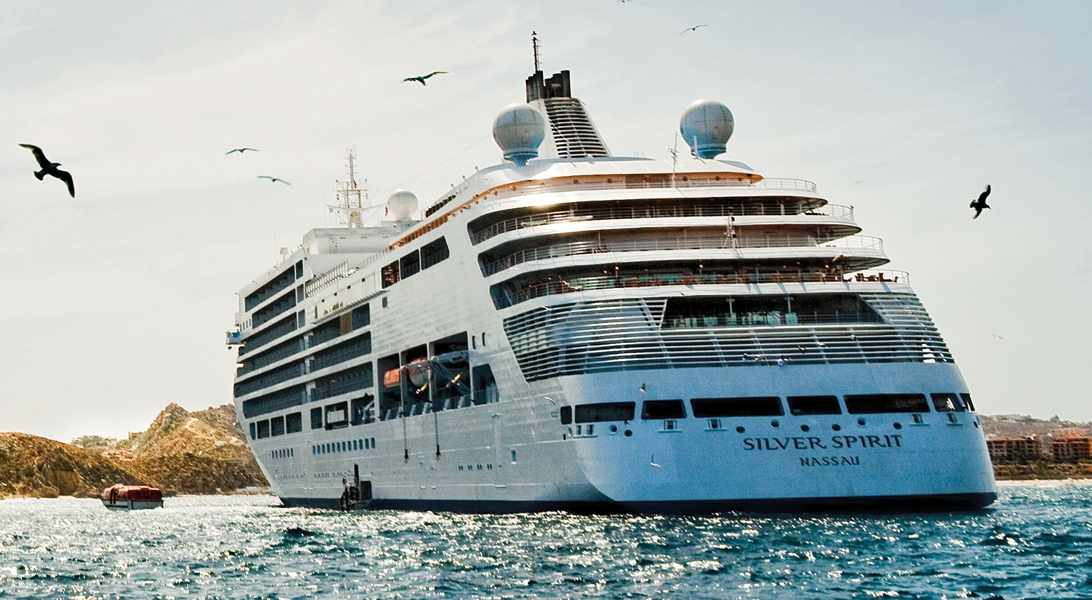
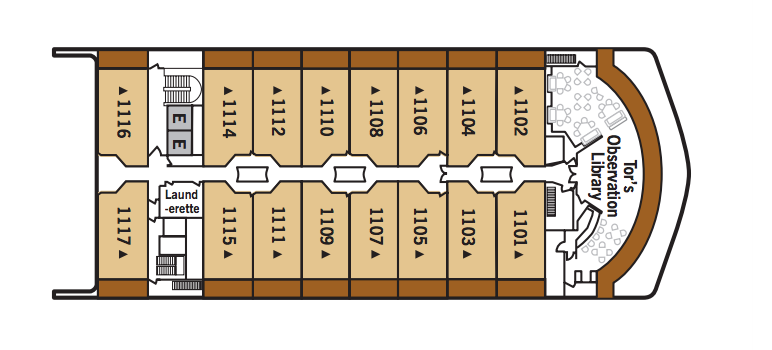







The images shown are for illustration purposes only and may not be an exact representation of what you find on the ship.
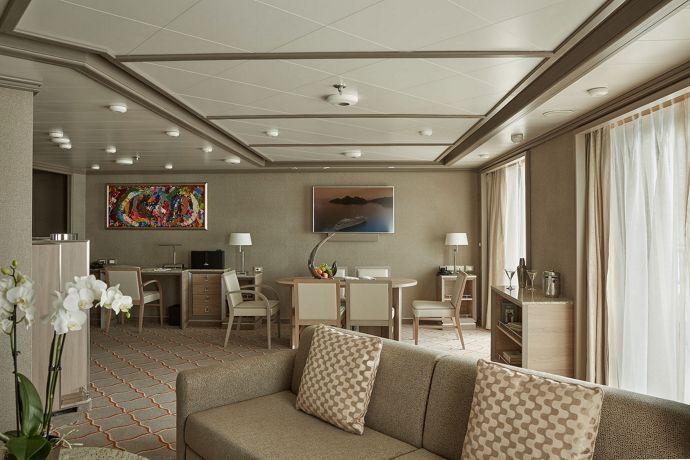
| Grade Code | From | To | |
| G1 | Grand Suite (1 Bedroom) | £22,500 | £22,500 |
| G2 | Grand Suite (2 Bedrooms) | £38,300 | £38,300 |
Expertly designed and exquisitely appointed. Ideal for entertaining friends while you cruise or enjoying a quiet dinner “at home”. Available as a one-bedroom configuration or as two-bedrooms by adjoining with a Veranda Suite.
One bedroom: 132-142 sq.m. including veranda
Two bedroom: 175 sq.m. including veranda
Please note that the 3rd guest will sleep on a comfortable sofa bed in the reception area of the suite.
Essentials
Characteristics
Furniture
Media & Communication
Onboard Services
Amenities
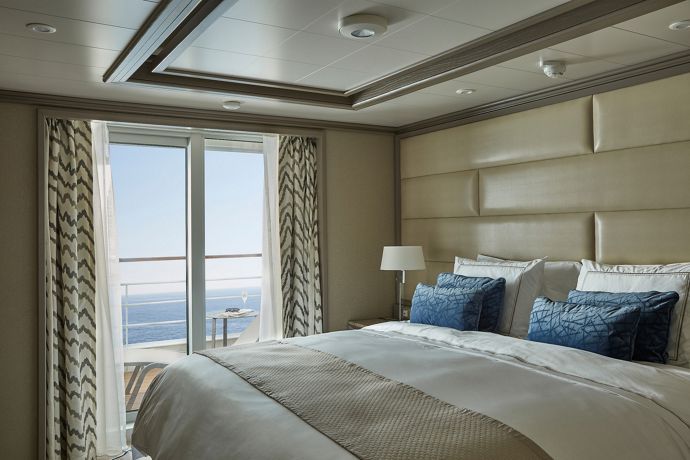
| Grade Code | From | To | |
| O1 | Owner's Suite (1 Bedroom) | £28,300 | £28,300 |
| O2 | Owner's Suite (2 Bedrooms) | £41,700 | £41,700 |
The name Owner's Suite says it all. A stylish apartment. Prestigious and classic. For those who seek the superlative level of space, comfort and service on board. Available as a one-bedroom configuration or as two-bedrooms by adjoining with Panorama Suite.
One bedroom: 1,292 sq. ft. / 120 m² including veranda
Two bedroom: 1,668 sq. ft. / 150 m² including veranda
Please note that the 3rd guest will sleep on a comfortable sofa bed in the reception area of the suite.
Essentials
Characteristics
Furniture
Media & Communication
Onboard Services
Amenities
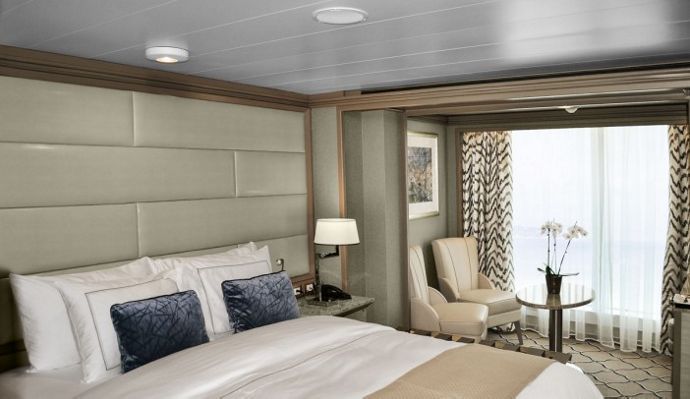
| Grade Code | From | To | |
| PA | Panorama Suite | £4,550 | £8,000 |
The Panorama Suite provides generous living space for voyagers. Located on deck 9, the Panorama offers all the comfort and attention to detail that you can expect aboard. A generous expanse of interior comforts — elegant décor, stunning marble bathroom and ample seating area, make this a cosy home away from home. The seating area of the Panorama Suite has plenty of room to relax, while large picture windows frame panoramic ocean views.
One bedroom: 334 ft² / 31 m²
Essentials
Characteristics
Furniture
Media & Communication
Onboard Services
Amenities

| Grade Code | From | To | |
| R1 | Royal Suite (1 Bedroom) | £18,900 | £18,900 |
| R2 | Royal Suite (2 Bedrooms) | £34,700 | £34,700 |
Stately describes the Royal Suite. Commanding and majestic. Perfect for entertaining. Enough living space to roam. The pinnacle of good living. Available as a one-bedroom configuration or as two bedrooms by adjoining with a Veranda Suite.
One bedroom: 92 sq.m. including veranda
Two bedroom: 127 sq.m. including veranda
Please note that the 3rd guest will sleep on a comfortable sofa bed in the reception area of the suite.
Essentials
Characteristics
Furniture
Media & Communication
Onboard Services
Amenities
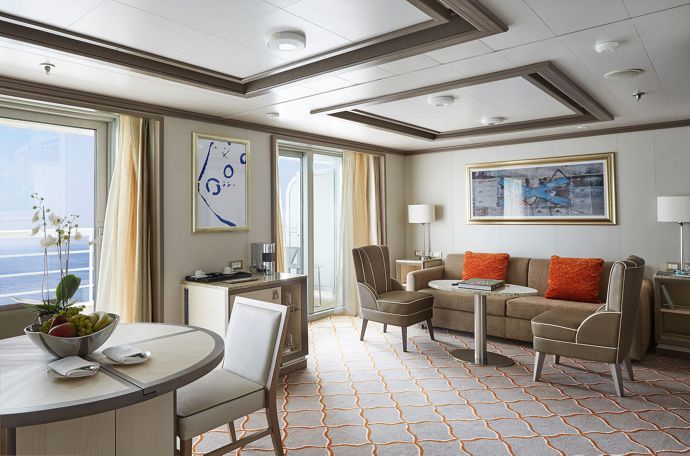
| Grade Code | From | To | |
| SL | Silver Suite | £13,000 | £13,000 |
| S2 | Silver Suite (2 Bedrooms) | £26,300 | £26,300 |
Step onto your terrace and bask in the calm feeling of the ocean breeze. Dissolve into the comfort of your king size bed. Prepare for the evening in the beautiful marble bathroom. The upper deck location gives the most spectacular of sea views, the spacious living area allows for comfortable relaxing where cosy nights in become veritable experiences in themselves. The two-bedroom configuration of this suite makes this it the ideal option for families.
One bedroom: 69 sq.m. including veranda
Please note that the 3rd guest will sleep on a comfortable sofa bed in the reception area of the suite.
Two bedroom: 100 sq.m. including veranda
Essentials
Characteristics
Furniture
Media & Communication
Onboard Services
Amenities
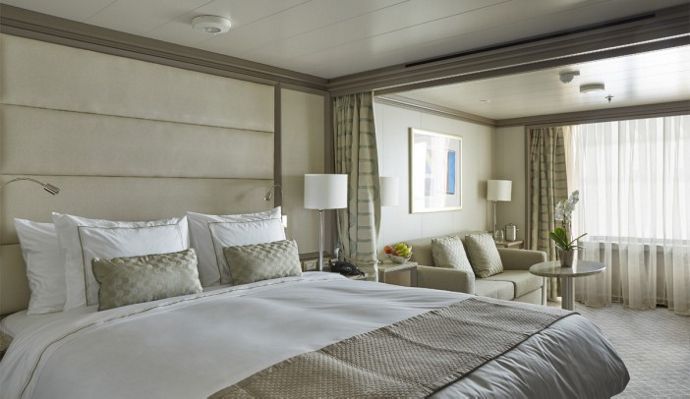
| Grade Code | From | To | |
| VI | Vista Suite | £4,450 | £6,900 |
A quiet sanctuary. The sitting area of the Vista Suite has plenty of room to relax. Large picture windows frame panoramic ocean views. The perfect backdrop for breakfast in bed during the cruise. Some Vista Suites accommodate three guests.
One bedroom: 32 sq.m.
Please note that the 3rd guest will sleep on a comfortable sofa bed in the reception area of the suite.
Essentials
Characteristics
Furniture
Media & Communication
Onboard Services
Amenities
The images shown are for illustration purposes only and may not be an exact representation of what you find on the ship.
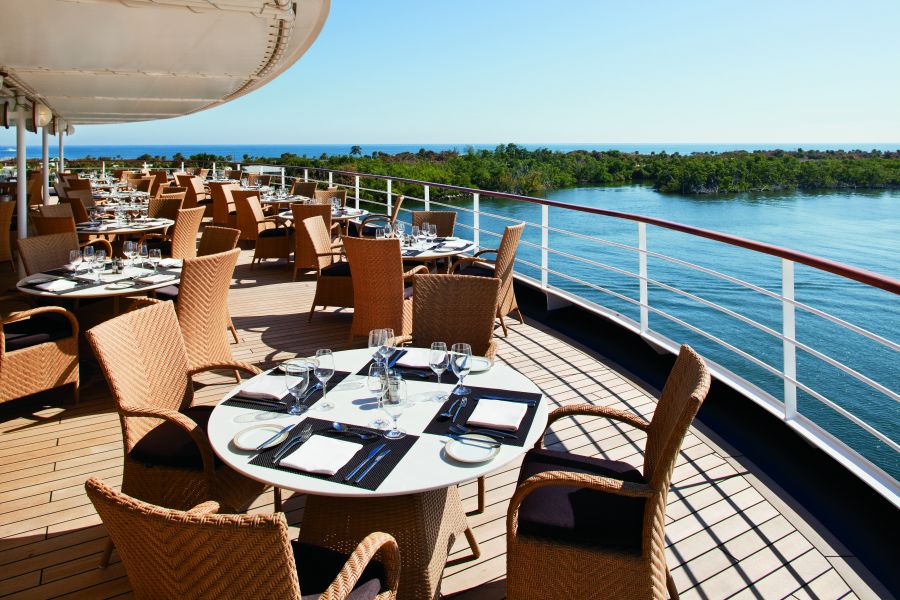
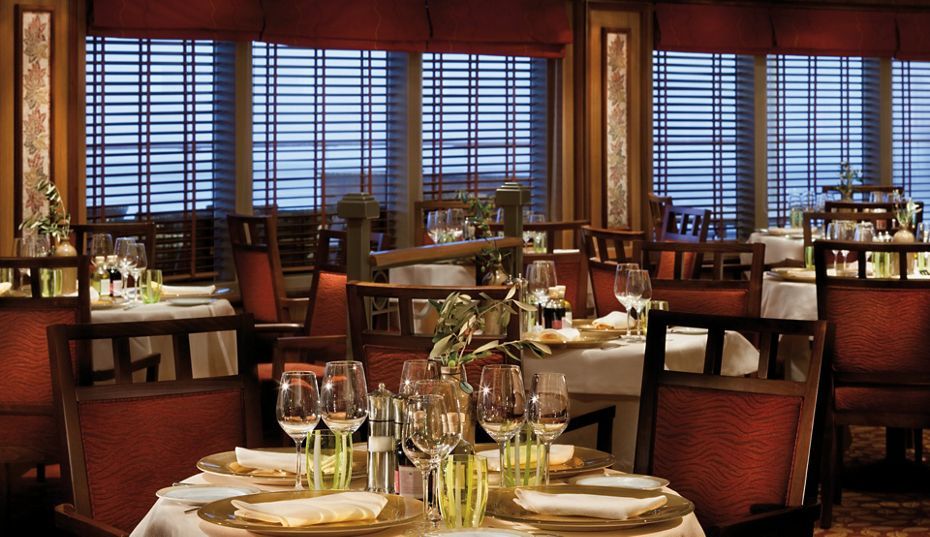
Authentic Italian recipes and the freshest, sustainable ingredients come together in this restaurant at sea.
On board this luxury cruise ship, a divine selection of Italy’s best cuisine is served à la carte in La Terrazza. Authentic recipes and the freshest ingredients come together with flair and passion — a flavourful expression of Silversea’s distinctive Italian herita ge. La Terrazza uses buffalo mozzarella from Naples, organic balsamic vinegar and olive oil from Umbria, and air-dried ham out of Parma. The Emilia-Romagna region also produces Silversea’s 24-month aged Parmigiano Reggiano, while the pasta is made daily right on board.La Terrazza is open for casual, buffet-style breakfast and lunch with indoor or al fresco dining on the outdoor terrace. During the evening, La Terrazza transforms into an à la carte traditional Italian restaurant.
Open-seating for breakfast and lunch. Reservations recommended for dinner.
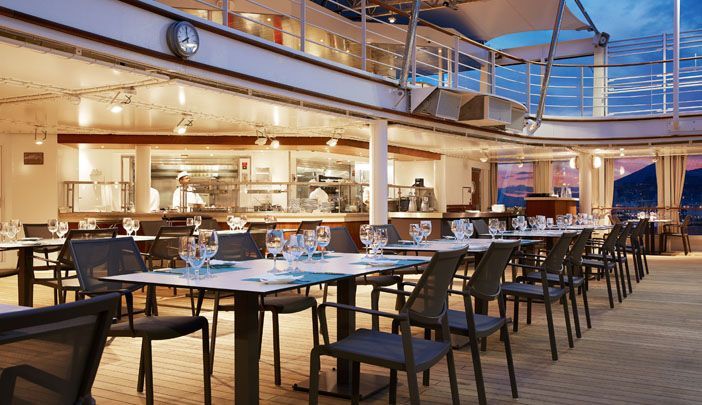
Soft breezes and ocean views beckon at the Grill, especially as the sun goes down when cruise guests gather for cocktails at the outdoor bar and talk about the day’s events.
One of the healthiest cuisines to exist, The Grill features lava stone cooking at its finest. Sourced from volcanic rock and placed in an oven to reach an optimum temperature of 400˚C, The Grill invites guests to cook their food directly at their table. Place your meat, fish or vegetables on top of the grill stone or inside the soup bowl, and then simply cook to your very own taste. Every bite is cooked to perfection, time after time. With the stone cooking available in the evenings only, The Grill becomes a gourmet salad and burger bar, offering build your own burgers from the best selections of meat.
Open seating for lunch. Reservation recommended for dinner.
The images shown are for illustration purposes only and may not be an exact representation of what you find on the ship.
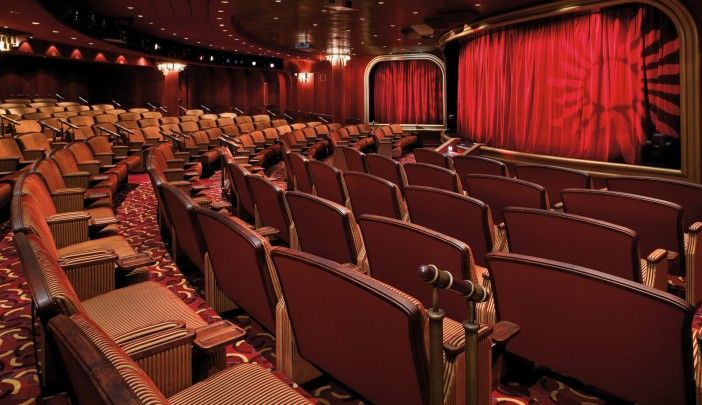
Applaud a broad spectrum of entertainment — from full-scale production shows and classical soloists, to cultural entertainment and feature films. Throughout your voyage, this luxury cruise ship’s Venetian Lounge also presents port talks, enrichment lectures and a variety of special events.

The Library on board this luxury cruise ship has an extensive selection of hardcover books, magazines, reference materials and newspapers, as well as audio listening stations. Movies are also available and can be viewed on your in-suite entertainment centre.
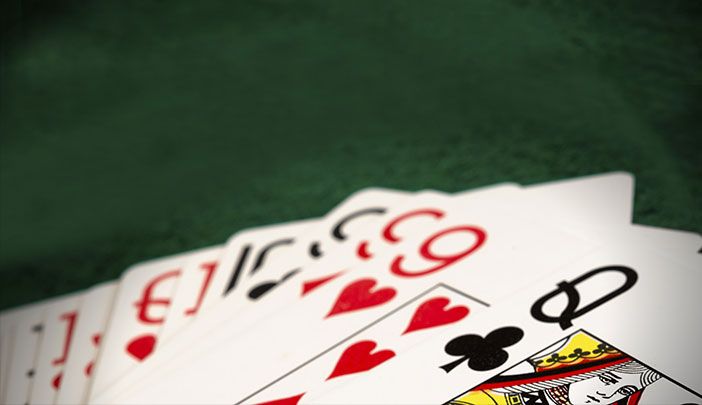
Whether it is for a card tournament or conference, Silversea will provide a dedicated space for the perfect guest experience.
Whatever your conference or meeting requirements, Silversea is pleased to provide a tailor-made experience. Audio-visual equipment is available and complimentary on board this luxury cruise ship.
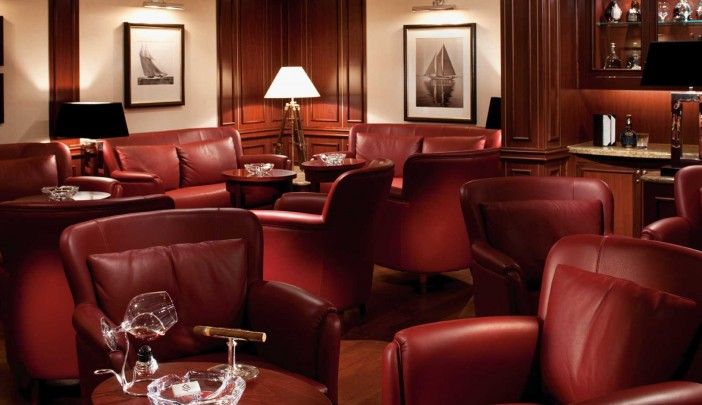
If you appreciate good cognac or premium cigars, be sure to visit the Connoisseur’s Corner to see the ship’s exceptional selection.
Discreet. Tasteful. Polished. If you appreciate the finer things in life, then the sophisticated touches of Connoisseur’s Corner will not disappoint. Rich and luxurious, yet airy and spacious, this indoor/outdoor venue is where you sip the finest cognac or whisky from a prestigious range and revel in the tranquil murmur of after-dinner conversation. A premium choice of cigars is also available, making this a perfect evening haven of serenity.
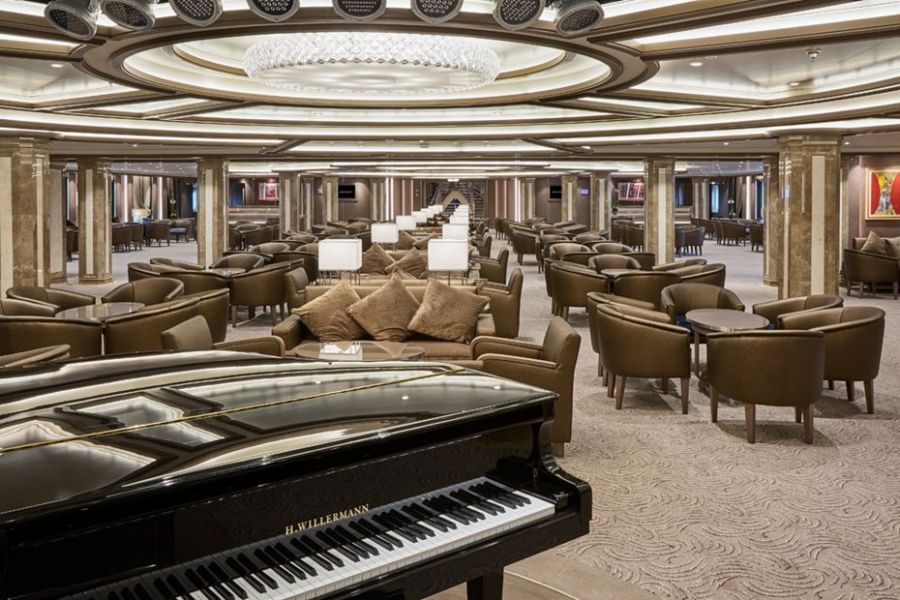
No cruise is complete without meeting new people. Enjoy complimentary drinks and live music at the bar while meeting other guests.
What could be a more fitting name for the very heart of Silver Spirit? Central to the soul and inspiration behind Silversea’s Italian heritage, Dolce Vita is the gathering place for our savvy travellers of the world, a place where guests mingle and exchange stories and where new faces become lifelong friends. Let us spoil you with an incredible array of flawless cocktails, wines and spirits, as you relax, enjoy the evening sounds of a live pianist and enjoy “the sweet life” aboard.
The images shown are for illustration purposes only and may not be an exact representation of what you find on the ship.
The images shown are for illustration purposes only and may not be an exact representation of what you find on the ship.
| Return flights including luggage allowance | |||
| Overseas Transfers | |||
| 16 nights aboard the Silver Spirit | |||
| Butler Service in Every Suite | |||
| Gratuities Always Included | |||
| Beverages In-Suite and Throughout the Ship | |||
| Gourmet Dining | |||
| In Suite Dining & 24-Hour Room Service | |||
| Intimate small size ships | |||
| Free Wifi Throughout the Ship | |||
| Free Zodiac, Land and Sea Tours & Activities & Complimentary Expedition gear | |||
| Port Taxes and Fees | |||
 | ABTA and ATOL Protection* | ||
Fly/cruise package |
Date 9th Mar 2025 |
Nts 16 |
Suite £4,450pp |
Suite £4,450pp |
Suite £4,450pp |
Suite £4,450pp |
Suite £4,450pp |
Suite £4,450pp |
Suite £4,450pp |
Suite £4,450pp |
Suite £4,450pp |
Suite £4,450pp |
Suite £4,450pp |
Suite £4,450pp |
Date 9th Mar 2025 |
Nts 16 |
Suite £4,450pp |
Suite £4,450pp |
Suite £4,450pp |
Suite £4,450pp |
Suite £4,450pp |
Suite £4,450pp |
Suite £4,450pp |
Suite £4,450pp |
Suite £4,450pp |
Suite £4,450pp |
Suite £4,450pp |
Suite £4,450pp |
| Suite staterooms from | £4,450pp | ||
| CV | Classic Veranda Suite | £5,150pp | |
| DX | Deluxe Veranda Suite | £5,450pp | |
| G1 | Grand Suite (1 Bedroom) |  | |
| G2 | Grand Suite (2 Bedrooms) |  | |
| O1 | Owner's Suite (1 Bedroom) |  | |
| O2 | Owner's Suite (2 Bedrooms) |  | |
| PA | Panorama Suite | £4,550pp | |
| R1 | Royal Suite (1 Bedroom) |  | |
| R2 | Royal Suite (2 Bedrooms) |  | |
| S2 | Silver Suite (2 Bedrooms) |  | |
| SL | Silver Suite | £13,000pp | |
| SV | Superior Veranda Suite | £5,350pp | |
| VI | Vista Suite | £4,450pp | |
| Suite staterooms from | £4,450pp | ||
| CV | Classic Veranda Suite | £5,150pp | |
| DX | Deluxe Veranda Suite | £5,450pp | |
| G1 | Grand Suite (1 Bedroom) |  | |
| G2 | Grand Suite (2 Bedrooms) |  | |
| O1 | Owner's Suite (1 Bedroom) |  | |
| O2 | Owner's Suite (2 Bedrooms) |  | |
| PA | Panorama Suite | £4,550pp | |
| R1 | Royal Suite (1 Bedroom) |  | |
| R2 | Royal Suite (2 Bedrooms) |  | |
| S2 | Silver Suite (2 Bedrooms) |  | |
| SL | Silver Suite | £13,000pp | |
| SV | Superior Veranda Suite | £5,350pp | |
| VI | Vista Suite | £4,450pp | |
| Suite staterooms from | £4,450pp | ||
| CV | Classic Veranda Suite | £5,150pp | |
| DX | Deluxe Veranda Suite | £5,450pp | |
| G1 | Grand Suite (1 Bedroom) |  | |
| G2 | Grand Suite (2 Bedrooms) |  | |
| O1 | Owner's Suite (1 Bedroom) |  | |
| O2 | Owner's Suite (2 Bedrooms) |  | |
| PA | Panorama Suite | £4,550pp | |
| R1 | Royal Suite (1 Bedroom) |  | |
| R2 | Royal Suite (2 Bedrooms) |  | |
| S2 | Silver Suite (2 Bedrooms) |  | |
| SL | Silver Suite | £13,000pp | |
| SV | Superior Veranda Suite | £5,350pp | |
| VI | Vista Suite | £4,450pp | |
| Suite staterooms from | £4,450pp | ||
| CV | Classic Veranda Suite | £5,150pp | |
| DX | Deluxe Veranda Suite | £5,450pp | |
| G1 | Grand Suite (1 Bedroom) |  | |
| G2 | Grand Suite (2 Bedrooms) |  | |
| O1 | Owner's Suite (1 Bedroom) |  | |
| O2 | Owner's Suite (2 Bedrooms) |  | |
| PA | Panorama Suite | £4,550pp | |
| R1 | Royal Suite (1 Bedroom) |  | |
| R2 | Royal Suite (2 Bedrooms) |  | |
| S2 | Silver Suite (2 Bedrooms) |  | |
| SL | Silver Suite | £13,000pp | |
| SV | Superior Veranda Suite | £5,350pp | |
| VI | Vista Suite | £4,450pp | |
| Suite staterooms from | £4,450pp | ||
| CV | Classic Veranda Suite | £5,150pp | |
| DX | Deluxe Veranda Suite | £5,450pp | |
| G1 | Grand Suite (1 Bedroom) |  | |
| G2 | Grand Suite (2 Bedrooms) |  | |
| O1 | Owner's Suite (1 Bedroom) |  | |
| O2 | Owner's Suite (2 Bedrooms) |  | |
| PA | Panorama Suite | £4,550pp | |
| R1 | Royal Suite (1 Bedroom) |  | |
| R2 | Royal Suite (2 Bedrooms) |  | |
| S2 | Silver Suite (2 Bedrooms) |  | |
| SL | Silver Suite | £13,000pp | |
| SV | Superior Veranda Suite | £5,350pp | |
| VI | Vista Suite | £4,450pp | |
| Suite staterooms from | £4,450pp | ||
| CV | Classic Veranda Suite | £5,150pp | |
| DX | Deluxe Veranda Suite | £5,450pp | |
| G1 | Grand Suite (1 Bedroom) |  | |
| G2 | Grand Suite (2 Bedrooms) |  | |
| O1 | Owner's Suite (1 Bedroom) |  | |
| O2 | Owner's Suite (2 Bedrooms) |  | |
| PA | Panorama Suite | £4,550pp | |
| R1 | Royal Suite (1 Bedroom) |  | |
| R2 | Royal Suite (2 Bedrooms) |  | |
| S2 | Silver Suite (2 Bedrooms) |  | |
| SL | Silver Suite | £13,000pp | |
| SV | Superior Veranda Suite | £5,350pp | |
| VI | Vista Suite | £4,450pp | |
| Suite staterooms from | £4,450pp | ||
| CV | Classic Veranda Suite | £5,150pp | |
| DX | Deluxe Veranda Suite | £5,450pp | |
| G1 | Grand Suite (1 Bedroom) |  | |
| G2 | Grand Suite (2 Bedrooms) |  | |
| O1 | Owner's Suite (1 Bedroom) |  | |
| O2 | Owner's Suite (2 Bedrooms) |  | |
| PA | Panorama Suite | £4,550pp | |
| R1 | Royal Suite (1 Bedroom) |  | |
| R2 | Royal Suite (2 Bedrooms) |  | |
| S2 | Silver Suite (2 Bedrooms) |  | |
| SL | Silver Suite | £13,000pp | |
| SV | Superior Veranda Suite | £5,350pp | |
| VI | Vista Suite | £4,450pp | |
| Suite staterooms from | £4,450pp | ||
| CV | Classic Veranda Suite | £5,150pp | |
| DX | Deluxe Veranda Suite | £5,450pp | |
| G1 | Grand Suite (1 Bedroom) |  | |
| G2 | Grand Suite (2 Bedrooms) |  | |
| O1 | Owner's Suite (1 Bedroom) |  | |
| O2 | Owner's Suite (2 Bedrooms) |  | |
| PA | Panorama Suite | £4,550pp | |
| R1 | Royal Suite (1 Bedroom) |  | |
| R2 | Royal Suite (2 Bedrooms) |  | |
| S2 | Silver Suite (2 Bedrooms) |  | |
| SL | Silver Suite | £13,000pp | |
| SV | Superior Veranda Suite | £5,350pp | |
| VI | Vista Suite | £4,450pp | |
| Suite staterooms from | £4,450pp | ||
| CV | Classic Veranda Suite | £5,150pp | |
| DX | Deluxe Veranda Suite | £5,450pp | |
| G1 | Grand Suite (1 Bedroom) |  | |
| G2 | Grand Suite (2 Bedrooms) |  | |
| O1 | Owner's Suite (1 Bedroom) |  | |
| O2 | Owner's Suite (2 Bedrooms) |  | |
| PA | Panorama Suite | £4,550pp | |
| R1 | Royal Suite (1 Bedroom) |  | |
| R2 | Royal Suite (2 Bedrooms) |  | |
| S2 | Silver Suite (2 Bedrooms) |  | |
| SL | Silver Suite | £13,000pp | |
| SV | Superior Veranda Suite | £5,350pp | |
| VI | Vista Suite | £4,450pp | |
| Suite staterooms from | £4,450pp | ||
| CV | Classic Veranda Suite | £5,150pp | |
| DX | Deluxe Veranda Suite | £5,450pp | |
| G1 | Grand Suite (1 Bedroom) |  | |
| G2 | Grand Suite (2 Bedrooms) |  | |
| O1 | Owner's Suite (1 Bedroom) |  | |
| O2 | Owner's Suite (2 Bedrooms) |  | |
| PA | Panorama Suite | £4,550pp | |
| R1 | Royal Suite (1 Bedroom) |  | |
| R2 | Royal Suite (2 Bedrooms) |  | |
| S2 | Silver Suite (2 Bedrooms) |  | |
| SL | Silver Suite | £13,000pp | |
| SV | Superior Veranda Suite | £5,350pp | |
| VI | Vista Suite | £4,450pp | |
| Suite staterooms from | £4,450pp | ||
| CV | Classic Veranda Suite | £5,150pp | |
| DX | Deluxe Veranda Suite | £5,450pp | |
| G1 | Grand Suite (1 Bedroom) |  | |
| G2 | Grand Suite (2 Bedrooms) |  | |
| O1 | Owner's Suite (1 Bedroom) |  | |
| O2 | Owner's Suite (2 Bedrooms) |  | |
| PA | Panorama Suite | £4,550pp | |
| R1 | Royal Suite (1 Bedroom) |  | |
| R2 | Royal Suite (2 Bedrooms) |  | |
| S2 | Silver Suite (2 Bedrooms) |  | |
| SL | Silver Suite | £13,000pp | |
| SV | Superior Veranda Suite | £5,350pp | |
| VI | Vista Suite | £4,450pp | |
| Suite staterooms from | £4,450pp | ||
| CV | Classic Veranda Suite | £5,150pp | |
| DX | Deluxe Veranda Suite | £5,450pp | |
| G1 | Grand Suite (1 Bedroom) |  | |
| G2 | Grand Suite (2 Bedrooms) |  | |
| O1 | Owner's Suite (1 Bedroom) |  | |
| O2 | Owner's Suite (2 Bedrooms) |  | |
| PA | Panorama Suite | £4,550pp | |
| R1 | Royal Suite (1 Bedroom) |  | |
| R2 | Royal Suite (2 Bedrooms) |  | |
| S2 | Silver Suite (2 Bedrooms) |  | |
| SL | Silver Suite | £13,000pp | |
| SV | Superior Veranda Suite | £5,350pp | |
| VI | Vista Suite | £4,450pp | |
Fusion Cruises when selling travel arrangements is a trading name of The Midcounties Co-operative Ltd. Fusion Cruises is an Accredited Body Member of Midcounties Co-operative Travel Consortium. (ABTA:P6652, ATOL:6053).
Book with Confidence. We are a Member of ABTA which means you have the benefit of ABTA’s assistance and Code of Conduct.
Some of the flights and flight-inclusive holidays on this website are financially protected by the ATOL scheme but ATOL protection does not apply to all holiday and travel services offered on this website. This website will provide you with information on the protection that applies in the case of each holiday and travel service offered before you make your booking. If you do not receive an ATOL Certificate then the booking will not be ATOL protected. If you do receive an ATOL Certificate but all parts of your trip are not listed on it, those parts will not be ATOL protected. Please see our booking conditions for information, or for more information about financial protection and the ATOL Certificate go to: www.caa.co.uk
